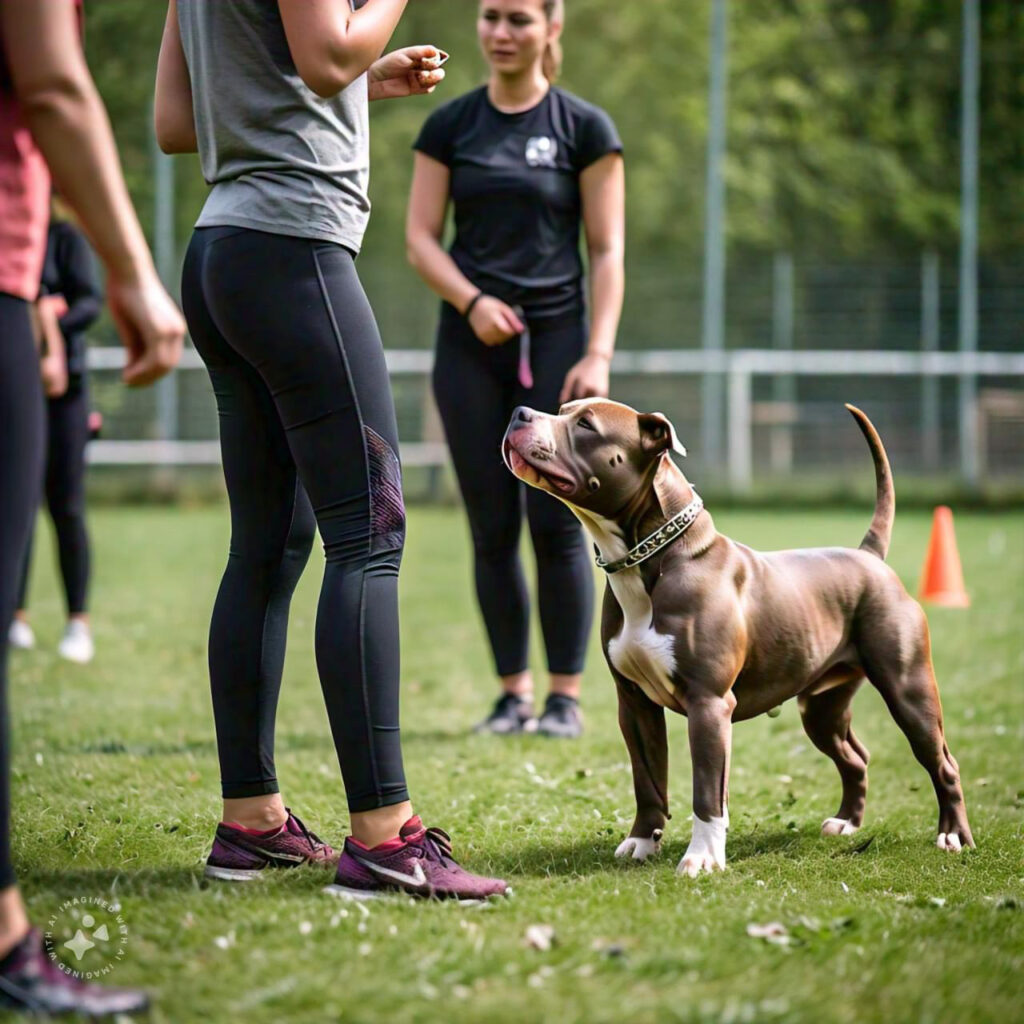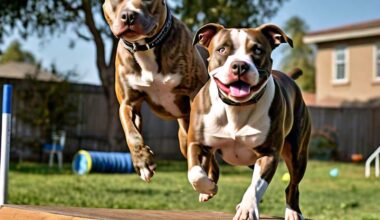Did you know pit bulls have a short memory, lasting only 5 seconds? This fact shows how challenging training them can be. But with the right tips, you will know how to train a pitbull.
These dogs are eager to learn and do well with the right guidance, it very possible to train your lovely pit bull. With the right methods, you can have a well-behaved, friendly pet that goes against common stereotypes.
Training a pit bull effectively means being consistent, patient, and using positive rewards. Start early and use rewards to tap into your pit bull’s intelligence and desire to please.
Let’s look at the key techniques to help you raise a well-adjusted, obedient pit bull.
Understanding Pitbull Temperament and Breed Characteristics
Pit bulls have a long history from 19th century England, Scotland, and Ireland. The United Kennel Club recognized the American Pit Bull Terrier in 1898.
They are known for their loyalty, intelligence, and courage. But, people often misunderstand their temperament.
History and Misconceptions
The history of Pit Bulls is closely linked to the old practice of bull-baiting in England. In this brutal dog fighting sport, dogs were set on a tied-up bull while people watched and bet on the fight. It showed off the dogs’ strength, toughness, and aggression.
The Old English Bulldog, which is now extinct, was first used for this sport. However, as people wanted more agile and fierce dogs, breeders started mixing bulldogs with terriers.
This aimed to combine the bulldog’s strength with the terrier’s quickness and determination. This crossbreeding created the genetic base for what we now know as the Pit Bull breed.
While Pit Bulls were originally bred as fighting dogs, today’s breeding focuses more on their temperament. This shift has created a breed known for its loyalty, affection, and intelligence.
Their past in dogfighting which was even more of dog sports has created the impression that they have an aggressive behavior and cannot be like any dog.
This has led to laws in some places. Yet, groups like the American Veterinary Medical Association say these laws don’t work well.
Typical Pitbull Traits
Pit bulls are known to be:
- athletic and do well in many activities
- They are 17-21 inches tall and weigh 30-60 pounds.
- They live 8-15 years.
- They are very affectionate, friendly, and playful.
- They need an hour of exercise daily to stay happy, this is important to note when you think of how to train a pit bull.
“Proper dog training, socialization, and enrichment are crucial for shaping a loving, affectionate, and faithful temperament in American pit bull terriers.”
Importance of Proper Training
Training a pit bull is vital to change pit bull misconceptions. These dogs learn best with positive reinforcement. Meaning it may take time and extra effort to train many pit bulls, if not all.
With the right care, starting training early and sometimes involving a professional dog trainer, pit bulls make great family pets. A well-trained pit bull is a happy pit bull!
- Focus on early socialization
- Provide mental and physical stimulation
- Use positive reinforcement techniques
- Maintain consistency in training
Starting Early: Puppy Training Basics
The ideal time to start training your Pit Bull puppy is right when you bring them home as a puppy. The first 16 weeks are key for good behavior. Puppies learn quickly and can pick up basic commands like sit, stay, and come.
Starting early also lays a good foundation for more advanced obedience and dog sports, which Pit Bulls can be great at. It is important to remember that pit bulls have short memory and it can take time to practice commands but the pit bull dog will respond once you continue training it.
Early training helps your pit bull become well-mannered and friendly as an adult.
When to Begin Training Your Pitbull Puppy
It’s best to start training between 3-8 weeks old.
The younger your Pit Bull, the faster they can learn new things. This gives them more potential for successful training overall, it also give you both time to practice obedience training and get better at it; eventually making your pit bull well-trained dog.
Puppies learn best during this time. By 8-12 weeks, they’re ready for commands like “come” and potty training.

Essential Commands for Young Pit bulls
Start with simple commands like “sit,” “stay,” and “down.” These are the basics. As they grow, add more complex commands.
Training should be short, about 5 minutes a day, to keep your puppy focused. give your dog more time to practice and respond to your commands.
Establishing a Consistent Training Routine
Consistency is vital in training pit bull puppies. Have a regular schedule for feeding, potty breaks, and training. This helps your puppy know what to expect and builds good habits. Use positive reinforcement, like treats or praise, for good behavior.
- Take your puppy out often for potty breaks
- Use puzzle toys for mental stimulation
- Limit dog park visits until 16 weeks old
- Groom regularly to build trust and bonding
“Early socialization is crucial for pit bull puppies to ensure they are comfortable with various people, another dog and different situations.”
Follow these tips to lay a strong foundation for your pit bull’s training. Patience and consistency are key to raising a happy, well-behaved pit bull.
Socialization: Key to a Well-Adjusted Pitbull

Socializing your dog is important to raising a friendly and well-adjusted dog. It helps prevent fear and aggression, fighting breed stereotypes. The best time to start is between 3 to 14 weeks old.
During this period, introduce your puppy to different people, animals, and places. This helps build their confidence and makes them associate new things with positive experiences.
Most pit bull owners believe social interaction and integration is crucial for a happy and well-adjusted dog.
Be aware of fear periods, which happen between 5-11 weeks and 6-12 months. During these times, make introductions gentle and positive. Don’t force interactions, as it can make things negative.
“Proper social interaction helps create well-adjusted, friendly Pit bulls and combats breed stereotypes.”
Socializing pit bulls can change their behavior for the better. When they’re socialized well, they’re great with kids and other dogs. In fact, 79.2% of owners say early training and consistent reinforcement make their pit bulls well-behaved and confident.
- Expose your pit bull to different people, animals, and environments
- Create positive experiences during socialization
- Be patient and consistent in your approach
- Use treats and praise to reinforce good behavior
Socializing little fur babies is a long-term process. Keep providing positive experiences and interactions to keep them friendly and confident.
Positive Reinforcement Techniques for Pitbull Training
Positive encouragement pit bull training changes the game for pet owners. It rewards good behavior, making it more likely to happen again.
This method strengthens the bond between you the dog owner and your pet.
The Benefits of Reward-Based Training
Rewards make pit bulls fun to train, and takes relatively less time to train. They link learning new skills with positive feelings. This approach works great for pit bulls, known for their smarts and desire to please.

Effective Rewards for Pitbulls
Pick rewards that get your pitbull excited. Treats, toys, and praise are great options. Some pitbulls like food rewards, while others prefer play or affection. Try different things to see what your dog enjoys most.
- Small, tasty treats
- Favorite toys
- Enthusiastic praise
- Extra playtime
Avoiding Punishment and Negative Reinforcement
Avoid punishment-based training. It can hurt your bond with your pit bull and cause fear or dog aggression. Instead, focus on stopping bad behaviors and rewarding the good ones.
“Positive reinforcement is not just about treats. It’s about creating a happy, confident dog who loves to learn.”
Consistency is crucial in positive reinforcement pitbull training. Keep training sessions short, fun, and regular for the best outcomes. With patience and the right approach, you’ll see great changes in your pitbull’s behavior and basic obedience.
How to Train a Pitbull: Advanced Commands and Skills
Are you ready to boost the obedience skills of your pit bull? Advanced training can turn your dog into a well-behaved friend. Let’s dive into some top commands and skills that will test your dog and deepen your connection.
Emergency recall is a key skill. It means your pitbull will come to you right away, even when there are distractions. Practice this in different places to make it reliable. Use treats and praise to encourage your dog during these drills.
Loose-leash walking is also vital. Teach your pit bull to walk by your side without pulling. It’s important to remember that this requires patience and consistency but makes walks much nicer.
“A Pit bull dog must excel in advanced obedience and sports training like agility and rally obedience.”
Think about Canine Good Citizen training. you would want to get the canine good citizen certification. This program tests your pit bull’s behavior in everyday situations. It’s a fantastic way to show off your dog’s good behavior and improve their obedience.
- Practice impulse control exercises
- Engage in agility training for mental stimulation
- Try advanced trick training
Remember, being consistent is crucial in advanced training. Keep training sessions short and enjoyable to keep your dog interested.
With hard work and positive rewards, your pit bull can learn these advanced skills and become a model citizen.
Managing Pitbull Energy: Exercise and Mental Stimulation
Pit bulls are energetic dogs and thrive with plenty of physical and mental stimulation. It’s crucial to meet their exercise needs for their overall health and behavior. As adults, Pitbulls should ideally get around two hours of exercise each day.
This can include taking your dog for regular walks, play sessions where they can run and fetch, and engaging in training activities.
Providing enough exercise not only keeps them physically fit but also helps to channel their energy positively, reducing the likelihood of boredom-related behaviors.
Physical Exercise Requirements for Pitbulls
To keep your Pitbull fit, try activities like brisk walks, fetch, and tug-of-war. These help burn off energy and keep them in shape.
If your Pitbull is dark-colored, you should plan your walks outside of the hottest hours of the day, so that he does not overheat (such as e.g. for merle Pit bulls, dark Razor Edge Pitties or black and white Pit bulls)
Always use safe outdoor areas and follow leash laws to keep your Pitbull safe.
your pit bull is likely to show behavioral problems if you to not engage them and stimulate them, this could lead to pit bull attacks.
Incorporating Mental Stimulation into Training
Just like they need exercise, Pit bulls also need mental challenges. Use puzzle toys, snuffle mats, and scent games to keep their minds sharp. Teaching new tricks and practicing obedience also keeps their minds busy. These activities stop boredom and reduce bad behavior.
Balancing Exercise and Rest for Optimal Behavior
It’s important to balance your Pitbull’s activity with rest. They need lots of exercise but also need calm times. Teach your Pitbull how to relax with a special routine. This mix of activity and rest helps them behave well and be a great friend.
Let’s Recap On How To Train A Pitbull
Let’s recap Pit Bulls: They have a short memory span but can still be trained effectively with the right methods. Known for their smarts, loyalty, and affection, they’ve come a long way from their bull-baiting past.
Training should emphasize positive reinforcement from an early age, starting with basic commands like ‘sit’ and ‘stay’ when they’re between 3-8 weeks old. Socializing them between 3-14 weeks helps create friendly Pit Bulls that defy stereotypes.
Rewards like treats and toys are crucial for positive training, while consistency and patience are key—avoiding punishment helps shape well-behaved dogs. For advanced training, think emergency recall and leash manners, even aiming for Canine Good Citizen certification.
To keep them happy and healthy, don’t forget plenty of exercise and mental challenges, balancing activity with good rest.




131 comments
Your article helped me a lot, is there any more related content? Thanks!
Your point of view caught my eye and was very interesting. Thanks. I have a question for you.
Your point of view caught my eye and was very interesting. Thanks. I have a question for you.
маркетплейс аккаунтов соцсетей купить аккаунт
заработок на аккаунтах https://marketplace-akkauntov-top.ru/
маркетплейс аккаунтов соцсетей https://magazin-akkauntov-online.ru/
площадка для продажи аккаунтов маркетплейс аккаунтов соцсетей
магазин аккаунтов социальных сетей маркетплейс для реселлеров
продажа аккаунтов соцсетей профиль с подписчиками
купить аккаунт с прокачкой магазин аккаунтов социальных сетей
Account Selling Service Account marketplace
Database of Accounts for Sale Account Store
Accounts marketplace Website for Buying Accounts
Buy Pre-made Account Sell accounts
Account Trading Platform Find Accounts for Sale
Account exchange Gaming account marketplace
Gaming account marketplace Secure Account Purchasing Platform
Verified Accounts for Sale https://socialmediaaccountsshop.com/
Sell accounts Ready-Made Accounts for Sale
Sell Account Verified Accounts for Sale
Account Acquisition Profitable Account Sales
account market account trading platform
purchase ready-made accounts buy and sell accounts
account trading platform marketplace for ready-made accounts
buy and sell accounts https://buyaccountsdiscount.com/
social media account marketplace buy accounts
account buying service marketplace for ready-made accounts
account selling platform account buying platform
buy and sell accounts account market
social media account marketplace profitable account sales
account trading account market
marketplace for ready-made accounts guaranteed accounts
account trading platform sell account
find accounts for sale account acquisition
secure account purchasing platform secure account purchasing platform
account store sell accounts
secure account sales find accounts for sale
find accounts for sale account trading
accounts market account exchange service
accounts market account market
account selling service verified accounts for sale
social media account marketplace account market
account selling service sell account
account trading platform account trading platform
account store account sale
purchase ready-made accounts verified accounts for sale
account catalog account sale
accounts market account exchange service
gaming account marketplace top-social-accounts.org
account store accounts marketplace
accounts market accounts market
account sale accounts market
database of accounts for sale https://accounts-marketplace.live/
database of accounts for sale buy accounts
sell account https://buy-accounts.space
ready-made accounts for sale buy-accounts-shop.pro
account trading https://accounts-marketplace.art/
sell account https://social-accounts-marketplace.live
accounts for sale account market
profitable account sales https://accounts-marketplace.online
account trading https://accounts-marketplace-best.pro
площадка для продажи аккаунтов https://akkaunty-na-prodazhu.pro/
магазин аккаунтов https://kupit-akkaunt.xyz
купить аккаунт https://rynok-akkauntov.top
биржа аккаунтов akkaunt-magazin.online
продать аккаунт https://akkaunty-market.live
площадка для продажи аккаунтов https://kupit-akkaunty-market.xyz
маркетплейс аккаунтов соцсетей https://akkaunty-optom.live
маркетплейс аккаунтов online-akkaunty-magazin.xyz
площадка для продажи аккаунтов akkaunty-dlya-prodazhi.pro
продать аккаунт kupit-akkaunt.online
fb accounts for sale https://buy-adsaccounts.work
buy facebook account facebook ad accounts for sale
buy facebook accounts https://buy-ad-account.top/
buying facebook account buy facebook old accounts
buy facebook accounts for ads buy account facebook ads
buy facebook advertising accounts buy facebook ad account
facebook ad account for sale https://ad-account-for-sale.top
buy facebook account facebook account buy
facebook ad accounts for sale buy ad account facebook
buy google adwords account https://buy-ads-account.top
buy google adwords account https://buy-ads-accounts.click/
buy fb account https://buy-accounts.click
google ads agency account buy google ads reseller
google ads account for sale buy google adwords account
sell google ads account https://buy-ads-invoice-account.top
buy google ads threshold accounts google ads accounts for sale
buy aged google ads accounts https://buy-ads-agency-account.top
adwords account for sale google ads agency accounts
buy google ads https://buy-verified-ads-account.work/
buy facebook business manager account buy verified facebook
buy aged google ads account buy aged google ads account
facebook business manager account buy buy-business-manager-acc.org
buy verified facebook business manager unlimited bm facebook
buy fb business manager https://buy-verified-business-manager-account.org/
buy verified facebook business manager https://buy-verified-business-manager.org/
buy verified facebook business manager facebook verified business manager for sale
unlimited bm facebook https://buy-business-manager-verified.org/
buy facebook business account https://buy-bm.org/
facebook bm for sale verified-business-manager-for-sale.org
buy facebook bm account buy-business-manager-accounts.org
buy tiktok ads https://buy-tiktok-ads-account.org
buy tiktok business account tiktok ads account for sale
buy tiktok ads accounts tiktok agency account for sale
buy tiktok ad account https://tiktok-agency-account-for-sale.org
tiktok ads agency account https://buy-tiktok-ad-account.org
buy tiktok ads https://buy-tiktok-ads-accounts.org
buy tiktok ads accounts https://buy-tiktok-ads.org
buy tiktok business account https://buy-tiktok-business-account.org
tiktok ads agency account https://tiktok-ads-agency-account.org
Can you be more specific about the content of your article? After reading it, I still have some doubts. Hope you can help me.
Your article helped me a lot, is there any more related content? Thanks!
Thanks for sharing. I read many of your blog posts, cool, your blog is very good.
Can you be more specific about the content of your article? After reading it, I still have some doubts. Hope you can help me.
Can you be more specific about the content of your article? After reading it, I still have some doubts. Hope you can help me.
Your article helped me a lot, is there any more related content? Thanks! https://accounts.binance.com/el/register-person?ref=IQY5TET4
Thank you for your sharing. I am worried that I lack creative ideas. It is your article that makes me full of hope. Thank you. But, I have a question, can you help me?
Your article helped me a lot, is there any more related content? Thanks!
Thank you, your article surprised me, there is such an excellent point of view. Thank you for sharing, I learned a lot.
Your point of view caught my eye and was very interesting. Thanks. I have a question for you.
Your point of view caught my eye and was very interesting. Thanks. I have a question for you.
I don’t think the title of your article matches the content lol. Just kidding, mainly because I had some doubts after reading the article.
Can you be more specific about the content of your article? After reading it, I still have some doubts. Hope you can help me. https://www.binance.info/vi/register-person?ref=WTOZ531Y
Can you be more specific about the content of your article? After reading it, I still have some doubts. Hope you can help me. https://accounts.binance.info/en/register-person?ref=JHQQKNKN
Can you be more specific about the content of your article? After reading it, I still have some doubts. Hope you can help me.
Thanks for sharing. I read many of your blog posts, cool, your blog is very good.
I don’t think the title of your article matches the content lol. Just kidding, mainly because I had some doubts after reading the article.
I don’t think the title of your article matches the content lol. Just kidding, mainly because I had some doubts after reading the article.
Your point of view caught my eye and was very interesting. Thanks. I have a question for you.
Reading your article helped me a lot and I agree with you. But I still have some doubts, can you clarify for me? I’ll keep an eye out for your answers.
Your point of view caught my eye and was very interesting. Thanks. I have a question for you.